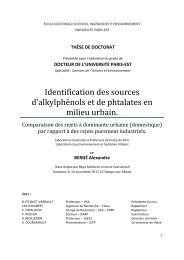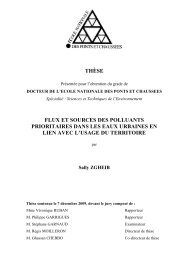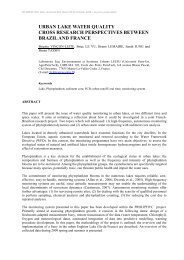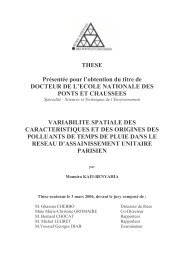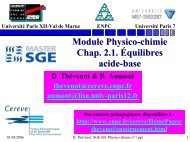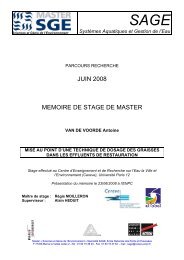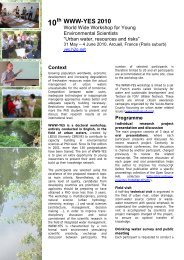View - ResearchGate
View - ResearchGate
View - ResearchGate
You also want an ePaper? Increase the reach of your titles
YUMPU automatically turns print PDFs into web optimized ePapers that Google loves.
3.3 SedimentationGenerally, Phewa Lake has broad and gentle sloped lake bottom except at the gorge portion.The sedimentation distribution is quite thin and in many places is beyond the accuracy of theinstruction for the sediment computation on annual basis. The sedimentation up to January2004 had been computed by the department of soil conservation. Therefore, here thesedimentation in the lake between the January 2004 and February 2006 is computed. Thedeposition or erosion of sediment is computed by multiplying the mean of the average waterdepths of two cross-section by the area of the reservoir surface between those two crosssections. The average sedimentation rate in the Phewa lake for the period of March 2000 toFeb 2006 is about 180000 cu. m. and in the silt trap area (1), it about 94000 cu. m. annually.3.5 Lake’s Storage CapacityThe gross capacity of the reservoir is computed by multiplying the mean of the average waterdepths of two contour lines by the area of the reservoir surface between those two contourlines using the bathymetric map (method II). During the highest water level, the area of lake is439 ha and the total capacity of the lake is estimated to be 42.2 million cubic meters (February2006). About 74% of the coverage area and 87% of the water volume are in the main reservoirarea(II). Similarly 10% of the coverage area and 8% of the water volume are in the riverchannel (III). Only 16% of the coverage area and 5% of the water volume are in the silt TrapArea .3.8. Life spans of the lake.The capacity of the lake is estimated as 42.18 million cu. m. with highest water level of+794.15 m. if the lake is considered to be dead, when 80% of the silted up and if the averagesedimentation rate about 180000 cu m. continue, the lake will be dead in about 190 years.Thesedimentation rate in the silt trap area for the period of 4 year (2000 to 2004) was about120000 cu. m. annually for the period between 2004 to 2006, it was only about 67750 cu. m.therefore, and the average sedimentation rate for the period from 2000 to 2006 in the silt traparea is about 94000 cu. m. With the annual average sedimentation of about 94000 cu. m. in thesilt trap area about 68 ha. (I.e. 16 % of the lake area ) it will be completely filled in 24 years.However, the result depends on how the Harpan Khola shifts with in the deltas. If thesedimentation rate of 67750 cu. m. continues in a silt trap area, it will be completely filled onlyin the next 33 years. The growth of the delta at the rate of about 2 hectares per year alsoindicate that in about 33 years the silt trap area (I) of about 68 hectare will be completelysilted up.4. CONCLUSIONThe water quality parameter of the three seasons in Phewa Lake suggest its eutrophic status.Among many station Hallan Chowk input highest amount of phosphorus due to this areadirect discharge solid waste . If the average annual sediment rate about 180000 cu. m. contain80% of Phewa lake storage capacity will be silt up in the next 190 years virtually making thePhewa lake useless there fore the silt trap area depending up on the situation of Harpan Kholawill be completely fill up in between 24 to 34 years reducing the 16 % of the lake area .Sediment monitoring is a tool to guide the concerned agencies for the formulation of necessarystrategy to protect the lake from sedimentation. Similarly study to understand the relationshipbetween climates; erosion processes in the watershed and sedimentation in the lake are needed.AcknowledgementsThe author wishes to acknowledge the invaluable direction, support and advice provided bythe JICA Project and Pokhara sub metropolitan city, Working Group. It is not an easy taskto be compressive in acknowledge the help received from different persons from different field.the everyday life dimension during this study period is important to emphasize ,as this wholestudy has been interwoven in to a large mosaic of moments of happiness and stress. With noexperience in interdisciplinary writing, I personally gained a lot from this opportunity topursue this research. This study really provided with a wide range of knowledge in both myacademic and professional field.REFERENCEBanskota, K., Sharma, B., 1998. Mountain tourism for local community development inNepal. A case study of Phewa lake side, Pokhara. Discussion paper 98/2, ICIMOD,KathmanduBower and Hansen (1980), water quality assessment of lakes, Austria 13(2) 67-71ppCBS (Central Bureau of Statistics), 1995. Statistical year book of Nepal. Kathmandu.DECORE, 1991. Socio- Economic Baseline Survey of Phewa Tal watershed. Prepared forintegrated watershed management project, Phewa Tal and Kulekhani watersheds.Department of soil conservation, Babar Mahal, Kathmandu, Nepal.12(3) 141-146ppDSC,1994. Sedimentation survey of Phewa Lake, Jan 1994. Department of soil conservation,Barbar Mahal, Kathmandu, Nepal. 109-113ppENPHO(1994)A review of limnological studies and research in Nepal .kathmandu Nepal13(3)65-71pp.ENPHO(1996) A report on “ The water source monitoring prgramme for the shivapuriwatershed by assessing water quality”19(4) 132-137pp.Fosbeg,C.&S.O.Ryding (1980),Eutrophication parameters and trophic state indicate in 30swedish was tereuiving lakes ;Arch,hydrobiol,89;189-207ppIUCN, 1995a. Phewa Lake conservation Action plan. National Planning Commission incollaboration with IUCN-The World Conservation Union, Kathmandu.IWMP, 1991b. Phewa Tal Siltation survey, base line date and the first results 1990-91,IWMP Technical paper no.2/1991. integrated watershed management project, Phewa Tal andKulekhani watersheds. Department of soil conservation, Barbar Mahal, Kathmandu, Nepal.IWMP, 1992a. Phewa Tal watershed landuse map (1991). Integrated watershed managementproject Phewa Tal and Kulekhani watersheds Department of soil conservation, Barbar Mahal,Kathmandu, Nepal.IWMP, 1992b. Integrated watershed management plan for Phewa Tal watershed, 1992. ).Integrated watershed management project Phewa Tal and Kulekhani watersheds Departmentof soil conservation, Barbar Mahal, Kathmandu, Nepal.IWMP,1991a. Phewa Tal Siltation survey, manual for echo-sounding, June 1991, updatedMay 1992. Integrated watershed management project, Phewa Tal and Kulekhani watersheds.Department of soil conservation, Babar Mahal Kathmandu Nepal.Rai, A.K, Shrestha, B.C., Joshi, P.L., Gurung, T. B., Nakanishi, M., 1995. Bathymetricmaps of Lakes of Phewa, Begnas and Rupa in Pokhara valley, Nepal. Memoirs of the Facultyof Science. Kyoto University (Series of Biology) 16, 49-54.SCOR/UNESCO (1960), surface water quality monitoring of lakes in Asian country 123-127ppShrestha .R.R.(1990) Biological and physiochemical –investigation of the Bagmati river(with specific reference to water pollution ) M.Sc thesis .central department of botanyT.U.kathmandu NepalShrestha, P., Janauer, G.A., 2001. Management of aquatic macrophyte resource: A case ofPhewa Lake, Nepal. In: P.K. Jha, S.R.Baral, S.B. Karmacharya, H.D. Lekhak, P. LacoulWWW-YES 2008, Paris 13 – 16 May 2008 193WWW-YES 2008, Paris 13 – 16 May 2008 194



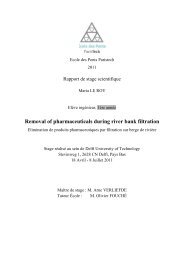
![[pastel-00730831, v1] Incidence des pratiques d'entretien ... - LEESU](https://img.yumpu.com/50938896/1/184x260/pastel-00730831-v1-incidence-des-pratiques-dentretien-leesu.jpg?quality=85)

